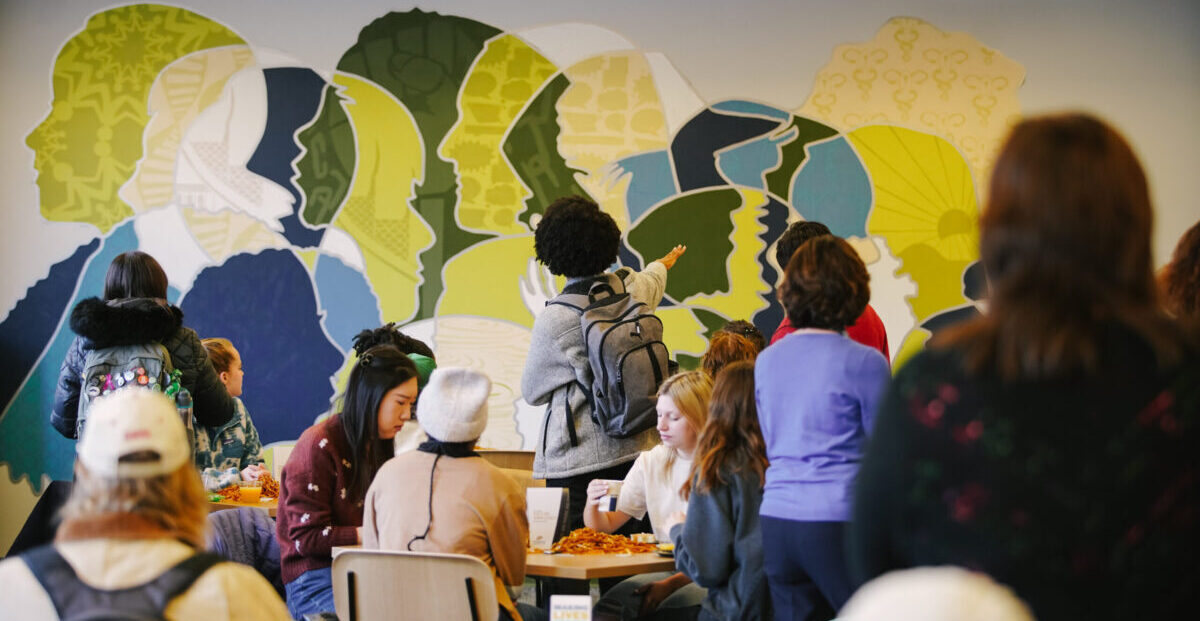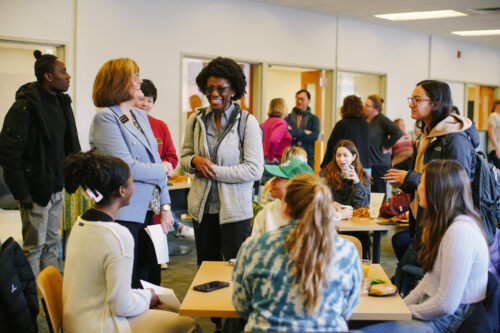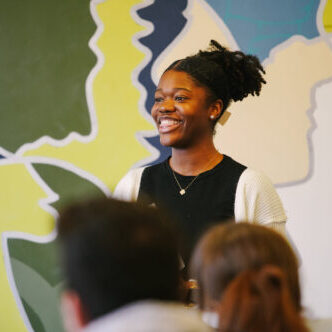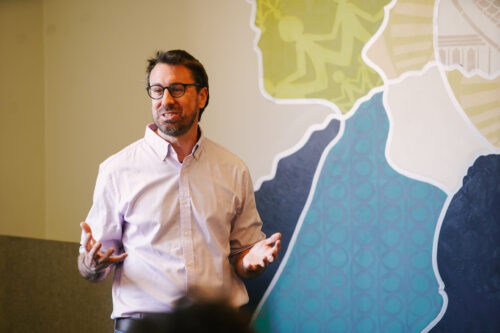HHS Connex Hub creates inclusive home on campus for Purdue HHS students
Written By: Rebecca Hoffa, rhoffa@purdue.edu

The HHS Connex Hub mural offers many different ways for HHS students to see themselves represented. (MorganJoy Photography)
From Marriott Hall to Lyles-Porter Hall and beyond, students in Purdue University’s College of Health and Human Sciences’ (HHS) learn, collaborate and work in research labs in 17 buildings scattered across the West Lafayette campus. To offer students a centralized space that facilitates inclusion and belongingness in HHS, the college recently opened the doors to the HHS Connex Hub in Stone Hall, Room 122, where students can comfortably study, socialize and collaborate between classes.

HHS Dean Marion K. Underwood talks with students during the HHS Connex Hub dedication on March 29.(MorganJoy Photography)
The space was formally dedicated on March 29 during HHS’ Life Inspired Week.
“From the get-go, this was intended to be an inclusive space,” said Margo Monteith, associate dean for diversity, equity and inclusion and distinguished professor of psychological sciences. “There’s a lot of research that supports the use of inclusive spaces for providing meaningful environments for students who often are not experiencing inclusion in other spaces across campus.”
The vision for the HHS Connex Hub first began during the second year of the COVID-19 pandemic as HHS’ business office, which formerly occupied Stone Hall, Room 122, transitioned to 100% remote work. To provide a welcoming a space where students from minoritized groups could feel a sense of belonging on campus, plans quickly developed to transform the space with comfortable furniture and a student-centered design. The idea of a mural was later introduced in collaboration with Mindy Tan, Purdue African American studies lecturer, and her spouse, artist Zach Medler, who brought the vision to life.
“As the College of Health and Human Sciences looked toward the future and evaluated how we do business, from where our people work to the resources we need, we saw Stone 122 as a wonderful opportunity to facilitate an inclusive student collaboration space to foster belonging in HHS,” said HHS Dean Marion K. Underwood, noting that the space will serve as a centralized family room for the college.

Kyndal Poore shares her experiences helping develop the space at the March 29 dedication.(MorganJoy Photography)
Unique in its approach, the development of the HHS Connex Hub strategically included HHS students from across the nine departments and schools in the college, with the HHS DEI Undergraduate Committee playing a particularly prominent role.
“I think it’s very easy, especially on a campus like Purdue’s, to try to be able to guess what students want,” said Tammy Conard-Salvo, assistant director for diversity, equity and inclusion. “It’s not just involving students but how you involve students that matters. A survey could not accomplish what we needed to have: actual student involvement, for them to put their stamp on the space, to feel a connection and ownership to the space.”
Conard-Salvo saw the enthusiasm over the course of the project as students voiced their excitement and plans to return to the space even after they graduate. Sophomore Kyndal Poore, who is majoring in biomedical health sciences, had an opportunity to speak at the HHS Connex Hub dedication event, sharing the impact this project has had on her and her peers.
“It makes me very happy to feel like I had a role in making somebody else’s new home or a new space that will give other people that sense of belonging,” Poore said. “I know what it’s like to not have that space or to not feel like you belong somewhere, so to have helped forge that space for some people, it is a blessing.”
In addition to being a comfortable space where students can study and engage with HHS peers, the space will also offer a spot where the HHS Connex program can host student events centered around diversity, equity, inclusion and belonging to which all HHS students are welcome.
A visual component of the HHS Connex Hub’s inclusion and belonging focus is the mural on the east wall. The commissioned artwork features interconnected profile outlines that represent the HHS DEI Undergraduate Committee student members. Each profile is filled in with symbols that represent the diversity of HHS students, from a Black power fist to the public health symbol interlaced with images of the female reproductive system. The symbols don’t just represent the committee members or illustrate the programs HHS offers but rather allow anyone who uses the space can find something to relate to hidden in the details.
Roughly 15 students from the committee and DEI working groups not only gave their input on the mural’s design, but they even got to help paint the mural.
“It really shows the strength of HHS,” Medler said. “There are so many different types of people in all of the different programs that (this college) offers. It’s just cool to see how they sort of came together to produce this project.

Artist Zach Medler shares insights about the mural at the March 29 dedication.(MorganJoy Photography)
“I feel like there’s a lot of power in that, and I think that comes through in the mural. I would not have been able to produce that myself, so allowing students to have so much input in the mural has produced something greater than what I could have done on my own.”
Students are already filtering in and out of the hub as the word spreads about HHS’ new and inviting space, some to study, some to work together on group projects and others to simply admire the artwork.
“Having the space in HHS is important because for a lot of minority students, they don’t have many places where they feel they belong on campus, and they have to try much harder to forge those spaces,” Poore said. “I think a lot of people just need a home on campus they can feel comfortable going to after classes or in between classes. We hope this space can be that for some people.”